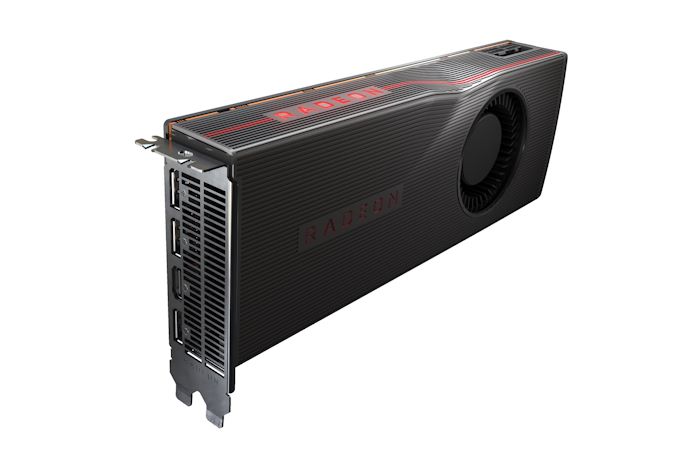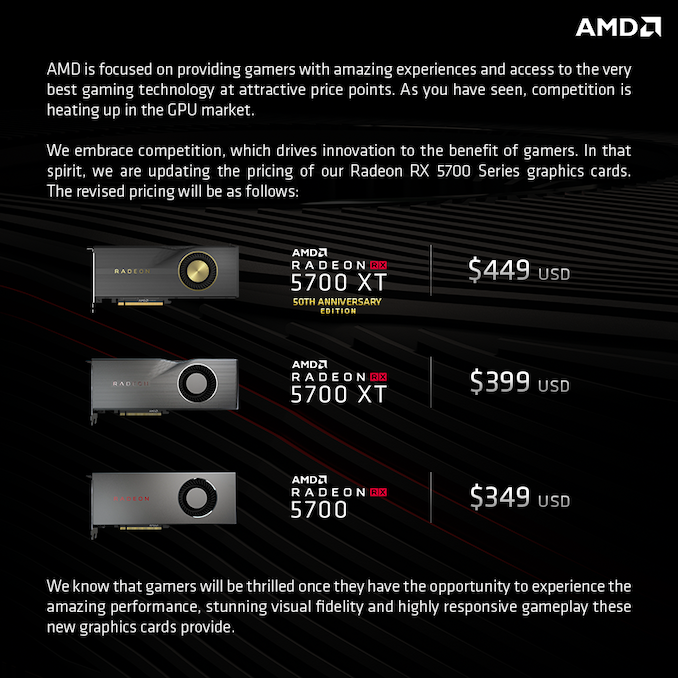AMD Adjusts Launch Price of Radeon RX 5700 Series: XT Down To $399, Standard Down To $349
by Andrei Frumusanu on July 5, 2019 5:30 PM EST- Posted in
- AMD
- GPUs
- Navi
- Radeon RX 5700

The new Radeon RX 5700 hasn’t even yet officially launched as we’re still awaiting Sunday the 7th of July, yet AMD in a rare event has now officially announced that is it adjusting the launch prices of the new Navi cards to lower price points.
Originally, the Radeon 5700 XT Anniversary edition, the XT, and the standard variant were priced at $499, $449, and $379. AMD has now lowered the price points to $449, $399 and $349.
| AMD Radeon RX Series Specification Comparison | ||||||
| AMD Radeon RX 5700 XT | AMD Radeon RX 5700 | AMD Radeon RX 590 | AMD Radeon RX 570 | |||
| Stream Processors | 2560 (40 CUs) |
2304 (36 CUs) |
2304 (36 CUs) |
2048 (32 CUs) |
||
| Texture Units | 160 | 144 | 144 | 128 | ||
| ROPs | 64 | 64 | 32 | 32 | ||
| Base Clock | 1605MHz | 1465MHz | 1469MHz | 1168MHz | ||
| Game Clock | 1755MHz | 1625MHz | N/A | N/A | ||
| Boost Clock | 1905MHz | 1725MHz | 1545MHz | 1244MHz | ||
| Throughput (FP32) | 9.75 TFLOPs | 7.9 TFLOPs | 7.1 TFLOPs | 5.1 TFLOPs | ||
| Memory Clock | 14 Gbps GDDR6 | 14 Gbps GDDR6 | 8 Gbps GDDR5 | 7 Gbps GDDR5 | ||
| Memory Bus Width | 256-bit | 256-bit | 256-bit | 256-bit | ||
| VRAM | 8GB | 8GB | 8GB | 4GB | ||
| Transistor Count | 10.3B | 10.3B | 5.7B | 5.7B | ||
| Typical Board Power | 225W | 180W | 225W | 150W | ||
| Manufacturing Process | TSMC 7nm | TSMC 7nm | GloFo/Samsung 12nm | GloFo 14nm | ||
| Architecture | RDNA (1) | RDNA (1) | GCN 4 | GCN 4 | ||
| GPU | Navi 10 | Navi 10 | Polaris 30 | Polaris 10 | ||
| Launch Date | 07/07/2019 | 07/07/2019 | 11/15/2018 | 08/04/2016 | ||
| Launch Price | $399 |
$349 |
$279 |
$179 |
||
The move isn’t unprecedented, but is something extremely rare. What is interesting is that AMD’s Scott Herkelman (CVP & GM AMD Radeon) yesterday posted an interesting but short tweet:
Jebaited
— Scott Herkelman (@sherkelman) July 4, 2019
Scott's snarky tweet is suggesting AMD had planned the move all along- playing a bait & switch in terms of the pricing of the RX 5700, most likely in preparation and in response to Nvidia’s newest Super card line-up.
We’re looking forward to covering the RX 5700 series cards when the time comes – hopefully soon!
Related Reading
Source: @Radeon on Twitter











78 Comments
View All Comments
eek2121 - Friday, July 5, 2019 - link
Since I can't edit, let me clarify. The per-transistor cost of 7nm is cheaper than 16nm. This means that an AMD chip on 7nm actually costs AMD less than 16 or 14nm. Ultimately what this boils down to is AMD could probably drop NAVI prices down another $100 or so and still be profitable, but they don't want to do that unless absolutely necessary. NAVI is a new architecture and "big" NAVI is coming out next year. They are trying to increase revenue in the GPU dept to catch up, get ahead, and stay ahead of NVIDIA, so they will only be dropping prices to remain competitive.nismotigerwvu - Friday, July 5, 2019 - link
One thing you forgot to mention is that Navi 10 has about half a billion less transistors than TU106. Calculating the exact cost per transistor isn't as straightforward as it seems as both AMD and NV leave quite a bit of dark silicon on the chips to allow for better thermals and prevent leakage and whatnot. The important bit is that even in the worst case scenario they are seeing equal cost per chip to NV in a Navi 10/TU106 comparison and likely have a noticeably lower cost in reality.Opencg - Saturday, July 6, 2019 - link
The TU106 dies used on the old 2060s only had 30 SMs enabled. The yields on the 2060 supers that the 5700 XTs compete against will be lower due to them having 34 SMs enabled.But the elephant in the room is RT and tensor cores. They take up silicon. Nvidia had a good architecture with pascal but you cant just throw on more and more silicon and keep your profit margins. AMD wins this one and they could probably go even lower to be honest.
Kevin G - Friday, July 5, 2019 - link
Bait and switch marketing with that clam. Per transistor reduction is expected but if you are able to squeeze more transistors into a given area, the net cost per die given equal area can still increase. The variable is just how much more can the transistors be crammed together.bobhumplick - Friday, July 5, 2019 - link
i doubt it. amd are barely getting 70% yields on a 70mm2 die with the zen 2 core dies. and it takes nearly twice as long to make a chip from start to finish because they are going from dual patterning to quad patterning. i would say a 7nm die that is 250mm2 (like the 5700) costs as much as at least a 350mm2 die, probalby closer to 400mm. they could still sell them cheaper but it costs lot more than polaris dies which are about the same size as these and still about the same as vega which is about 330mm2. but that vega die is from glofo which is the bargain basement chip supplier. so the 7nm would cost a lot more still than vega but they dont have to buy hbm.the 2070 is about 440mm2 and i would think they would cost a tiny bit more but then yields would actually make the 2070 about the same price since 12nm will yield better.
Audacioucity - Saturday, July 6, 2019 - link
Nvidia 2060 Super is 445 mm2, cut down a little bit. AMD 5700 is 251 mm2 and also cut down. The reason why the 5700s will always be cheaper is not on the actual process itself, the transistor count or the defect density. According to https://caly-technologies.com/die-yield-calculator... evenat a worst-case scenario that 7nm has 4 times the defect density of 12nm (which is very unlikely for mass production), AMD will still get more chips per wafer thanks to the smaller size.
edzieba - Saturday, July 6, 2019 - link
" The per-transistor cost of 7nm is cheaper than 16nm. "That's not true, cost/transistor has been rising with each process scaling since 28nm.
Santoval - Saturday, July 6, 2019 - link
"This means that an AMD chip on 7nm actually costs AMD less than 16 or 14nm."No it doesn't. That's because CPU/GPU companies do not sell their products based on the number of transistors. They sell CPUs & GPUs with a different number of transistors, with the number of transistors not being a selling point (their number might be mentioned in their technical data, but it's rarely used for marketing).
Thus what actually matters to them is the total cost per die, taking into account all R&D costs, yields per wafer, and finally its packaging into a complete chip. The largest (or at least a very large, I don't have precise numbers) part of the R&D is done by the company designing the new CPU/GPU, not the foundry that fabs it. So that cost is not included in TSMC's cost profile because they don't really care about it.
The yields per wafer (of dies, not of... transistors) are obviously lower with each new node. That has always been the case, but as we reached single digit nm nodes it got even worse, while the R&D costs of developing each CPU/GPU went also through the roof.
In short the total cost per die at 7nm (for AMD, Nvidia etc, not the foundries) will be clearly higher at first when the yields are low and eventually (as the node matures and the yields increase, and as the foundries' clients have recuperated some of their R&D costs), it will reach parity with the previous nodes or be slightly cheaper.
saratoga4 - Friday, July 5, 2019 - link
>7nm has better yields equal to 16nm according to TSMC.This is not true. They are hoping to have them comparable by the end of the year, which would still leave 7nm quite a bit more expensive.
Samus - Saturday, July 6, 2019 - link
Yeah, if 7nm had even good yields, they wouldn't have like 5 versions of the same die...Navi 10, 12, 14, 21 or whatever, etc etc. There are a ton of harvested dies that make up different versions of it.